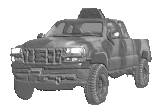|
|
For
participants only. Not for public distribution.
|
Note #19
John Nagle |
(Preliminary)
Can two do what one cannot easily do?
Introduction
We're now looking at using two different laser rangefinders. The first is a short-range one with good resolution (a few cm, but range limited to 15-10m) and a wide field of scan. The short range means the collecting optics can be smaller, which makes the 2D scanning machinery much more compact and rugged.
The long-range unit has a specialized job - deciding if the road ahead is flat. It needs more range, but only half-meter precision (the oblique angle helps you here.) It will have a very narrow scan angle, less than 10 degrees, and will just scan small ellipses using a rotating mirror. Because it's not a true 2D scanner, it's a mechanically simple device. Processing consists mostly of checking that the range deltas between successive measurements are small. As long as they are, it's looking at a relatively flat surface.
The long-range unit goes on a standard pan-tilt head, which will be used to aim it at where the vehicle expects to be soon, about 1.5 stopping distances out. Thus, we can go fast on flat surfaces, and can get good detail at short ranges for difficult sections. Bob Clark, our laser rangefinder guy, doesn't see any problem building either of these. Building one unit that does both jobs is tough, because you need a big receiving aperture and the ability to move it around fast. Separating the two simplifies the problem. The short range unit needs a 1-2" aperture, and the long-range unit needs a 4-5" aperture. He has an 5" elliptical scanner prototype now, and was planning to scan it back and forth rapidly with a Really Big Servomotor, but none of us were happy about that mechanism. Modifications to existing Acuity rangefinders should do the short-range job; it's the long-range problem that is hard.
There's one kicker in this. We can see a cliff, but not a big pothole, at long range using a low-res rangefinder. The return from the far side of the pothole is too close to where it would be for a flat surface. The DARPA organizer says there won't be any deliberate "negative obstacles". If we're on a road, we can assume, with some risk, that there won't be a big enough hole to eat a Polaris Ranger. People often can't see such things either, of course.
The short-range laser rangefinder
For the short-range unit, we need a large field of view. 90 degrees horizontally and 45 degrees vertically would be ideal. The short range unit should have distance measurement resolution to 15cm or better. The Acuity AR4000-LIR has the resolution, although the range is only 18 meters. This would limit us to speeds of 20MPH or so on the short-range system alone. That's probably adequate.
The scan density and data rate should be such that we get five points in each 15cm area in the scan on each scan. (Those are the values CMU used in their off-road laser rangefinder NavLab system.) Ideally, our data points are equally spaced throughout a 90 degree wedge with a 20 meter radius. That wedge has an area of about 300 square meters, so it has 15,000 15cm cells. We'd like to get a 5 FPS sampling rate. So we'd need 375,000 points per second. This is 6x the rate for the Acuity unit. Can we get those requirements down?
Suppose we use a 25cm cell. That's about the width of our tires. Now we only have 4800 cells. 4800 x 5 x 5 = 120,000 samples/second. If we drop to 4 FPS, we're down to 96,000 samples/sec, which is 2x over the existing technology. Can we get there?
That's a rough calculation. Let's try it another way. Assume a fast horizontal scan of 90 degrees and a slow vertical scan of 45 degrees.
A 90 degree arc with a 20 meter radius has an arc length of 31.4 meters.
We'd need 125 samples over that length to get 25cm resolution.
A 45 degree arc with a 20 meter radius has an arc length of 15.7 meters.
We'd need 62 samples over that length to get 25cm.
So that's roughly what we need in a scanner - 62 lines of 125 pixels each, or 7750 pixels.
Suppose we require 3 pixels per cell to get a roughness estimate for the cell, and we take those pixels in the same scan line. This gives us 62 lines of 375 pixels, or 23250 pixels. To get 4FPS, we need 93,000 samples/second. So we get roughly the same number that way.
There's a line scanner for the AR4000, but we need a 2D scanner. Is anything suitable available on the shelf?
The long-range laser rangefinder
The long-range unit needs a much smaller field of view and quite modest accuracy in depth measurement. 0.5 meter depth measurement accuracy would be good; 1 meter would be acceptable. The field of view should be about two lanes wide at maximum range, say 6 meters wide at 50 meters out, which is about 7 degrees or 0.12 radians. We'd like to get enough points in the scan that every 15cm area in the scan gets hit two or three times as the vehicle advances forward at top speed. (Need to calculate this.)
The laser rangefinder in the SICK Optic LMS 211 scanning laser rangefinder has a claimed range of 45 meters outdoors with ±35cm accuracy. That comes with a 90° or 180° line scanner, which is not helpful in this application. The rangefinder may be available separately as a DME part number.
Bob Clark's elliptical scanner should work in this application. All we need is coverage of the area of interest. Any scan pattern would work, including a random one. We need to be able to point the scanner, but the performance required is that of a good pan-tilt head, not a scanning mirror.
